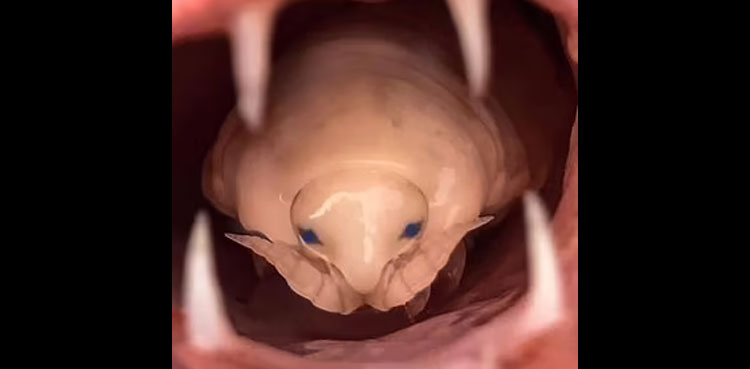Tongue-eating louse found in the mouth of a fish, see photos
- By Web Desk -
- May 11, 2021

CAPE TOWN: In a shocking discovery, a scientist found a tongue-eating parasite in the mouth of a fish in South Africa.
According to the details, Don Marx, 27, was fishing near Cape Agulhas when he hooked the six-pound carpenter fish and discovered the louse inside its jaws.

Marx, who happens to study marine biology, snapped a picture of the parasite and sent the photo to Professor Nico Smit, a zoologist at North-West University. The professor told him that this particular species of louse has never been photographed before.
Talking about his discovery, Marx said, ” I opened the carpenter’s mouth and saw this blue eyed alien with a moustache staring back at me. This specific species of tongue-eating louse only uses carpenters as their host and has eluded scientists for years.”
It is thought that all species of tongue-eating lice begin their lives as males, drifting in the ocean and looking for fish to latch on to.

Once the louse has found a host fish of the right species, it swims through the fish’s gills and makes itself at home. If the host fish does not have any other lice already in place, the new louse makes its way into the mouth, where it attaches itself to the tongue.
Using its front claws, the louse severs blood vessels in the tongue and then feeds by drinking the blood.
During this time, the male will transform into a female – its body increasing several times in size along with its legs, which it uses to latch on to the fish.
Meanwhile, its eyes dwindle since it no longer needs to navigate around.
When the fish’s tongue eventually dies and falls out due to lack of blood, the louse latches on to the tongue stump and effectively replaces it.
According to a 1983 research paper, the louse ‘replaces the mechanical function of the tongue’ by helping the fish hold prey against the roof of its mouth while it feeds.
The parasite will then live in the fish’s mouth for the rest of both their lives, feeding on the fish’s blood and mucus, but otherwise causing no other harm.
If a louse arriving in a host fish finds that a female is already in place, it will remain as a smaller male and attach to the fish’s gills instead, Mail Online reported.
Males live their whole lives in the gills, occasionally breeding with the female inside the fish, producing live young which are expelled through the gills after birth to find their own host.
It is possible for fish to host several males as well as a female, and in these fish it is common for them to be under-weight – likely due to several parasites feeding on their blood.
During lab studies, the lice have been seen leaving the mouth of the fish only after it dies, often clinging on to the outside of its head or body.
However, little is known about what happens to lice whose hosts die in the wild.
